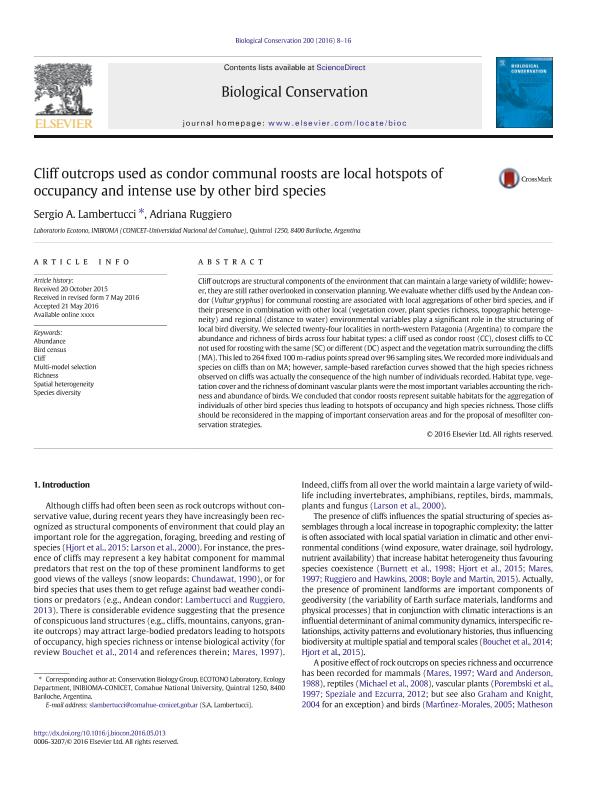Mostrar el registro sencillo del ítem
dc.contributor.author
Lambertucci, Sergio Agustin

dc.contributor.author
Ruggiero, Adriana

dc.date.available
2019-02-12T18:00:24Z
dc.date.issued
2016-08-01
dc.identifier.citation
Lambertucci, Sergio Agustin; Ruggiero, Adriana; Cliff outcrops used as condor communal roosts are local hotspots of occupancy and intense use by other bird species; Elsevier; Biological Conservation; 200; 1-8-2016; 8-16
dc.identifier.issn
0006-3207
dc.identifier.uri
http://hdl.handle.net/11336/69981
dc.description.abstract
Cliff outcrops are structural components of the environment that can maintain a large variety of wildlife; however, they are still rather overlooked in conservation planning. We evaluate whether cliffs used by the Andean condor (Vultur gryphus) for communal roosting are associated with local aggregations of other bird species, and if their presence in combination with other local (vegetation cover, plant species richness, topographic heterogeneity) and regional (distance to water) environmental variables play a significant role in the structuring of local bird diversity. We selected twenty-four localities in north-western Patagonia (Argentina) to compare the abundance and richness of birds across four habitat types: a cliff used as condor roost (CC), closest cliffs to CC not used for roosting with the same (SC) or different (DC) aspect and the vegetation matrix surrounding the cliffs (MA). This led to 264 fixed 100 m-radius points spread over 96 sampling sites. We recorded more individuals and species on cliffs than on MA; however, sample-based rarefaction curves showed that the high species richness observed on cliffs was actually the consequence of the high number of individuals recorded. Habitat type, vegetation cover and the richness of dominant vascular plants were the most important variables accounting the richness and abundance of birds. We concluded that condor roosts represent suitable habitats for the aggregation of individuals of other bird species thus leading to hotspots of occupancy and high species richness. Those cliffs should be reconsidered in the mapping of important conservation areas and for the proposal of mesofilter conservation strategies.
dc.format
application/pdf
dc.language.iso
eng
dc.publisher
Elsevier

dc.rights
info:eu-repo/semantics/openAccess
dc.rights.uri
https://creativecommons.org/licenses/by-nc-sa/2.5/ar/
dc.subject
Abundance
dc.subject
Bird Census
dc.subject
Cliff
dc.subject
Multi-Model Selection
dc.subject
Richness
dc.subject
Spatial Heterogeneity
dc.subject
Species Diversity
dc.subject.classification
Otras Ciencias Biológicas

dc.subject.classification
Ciencias Biológicas

dc.subject.classification
CIENCIAS NATURALES Y EXACTAS

dc.title
Cliff outcrops used as condor communal roosts are local hotspots of occupancy and intense use by other bird species
dc.type
info:eu-repo/semantics/article
dc.type
info:ar-repo/semantics/artículo
dc.type
info:eu-repo/semantics/publishedVersion
dc.date.updated
2019-02-05T19:52:58Z
dc.journal.volume
200
dc.journal.pagination
8-16
dc.journal.pais
Países Bajos

dc.journal.ciudad
Amsterdam
dc.description.fil
Fil: Lambertucci, Sergio Agustin. Consejo Nacional de Investigaciones Científicas y Técnicas. Centro Científico Tecnológico Conicet - Patagonia Norte. Instituto de Investigaciones en Biodiversidad y Medioambiente. Universidad Nacional del Comahue. Centro Regional Universidad Bariloche. Instituto de Investigaciones en Biodiversidad y Medioambiente; Argentina. Universidad Nacional del Comahue. Centro Regional Universitario Bariloche. Laboratorio de Ecotono; Argentina
dc.description.fil
Fil: Ruggiero, Adriana. Consejo Nacional de Investigaciones Científicas y Técnicas. Centro Científico Tecnológico Conicet - Patagonia Norte. Instituto de Investigaciones en Biodiversidad y Medioambiente. Universidad Nacional del Comahue. Centro Regional Universidad Bariloche. Instituto de Investigaciones en Biodiversidad y Medioambiente; Argentina. Universidad Nacional del Comahue. Centro Regional Universitario Bariloche. Laboratorio de Ecotono; Argentina
dc.journal.title
Biological Conservation

dc.relation.alternativeid
info:eu-repo/semantics/altIdentifier/doi/http://dx.doi.org/10.1016/j.biocon.2016.05.013
dc.relation.alternativeid
info:eu-repo/semantics/altIdentifier/url/https://www.sciencedirect.com/science/article/abs/pii/S000632071630194X?via%3Dihub
Archivos asociados
